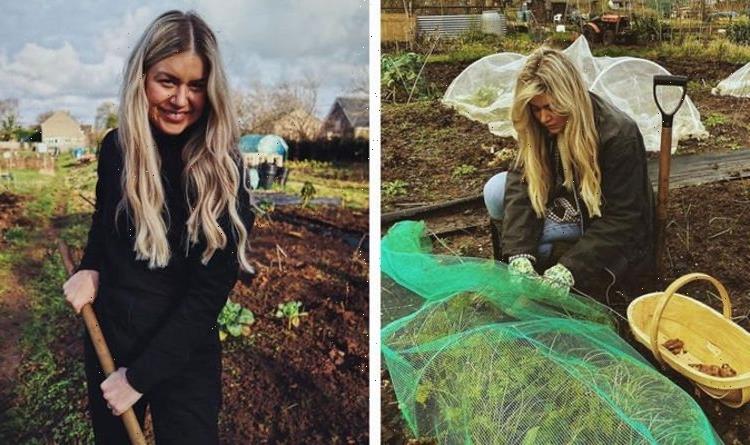This Morning: Daisy Payne shares tips for planting spinach
We use your sign-up to provide content in ways you’ve consented to and to improve our understanding of you. This may include adverts from us and 3rd parties based on our understanding. You can unsubscribe at any time. More info
Daisy Payne is a self-confessed “passionate gal” who just wants to “get loads more people into gardening because there’s so much to enjoy”. And while the blooming plants and flowers of summer make way for leaves falling in autumn before the cold spell in December sets in, there are many things gardeners can do in and around their plot. While the number one job might be to have a good tidy and sort out, Daisy warns against doing this too enthusiastically because of the wildlife that need shelter and food over the winter months.
Don’t disturb undergrowth too much
“This is a time of year your gut instinct is to give the garden a really tidy up, which I completely relate to and will do myself,” Daisy said.
“But I think one of the things that we can all do, is not disturb the undergrowth too much.
“This is in terms of where there are leaves and sticks piled up, or a compost heap.
“If you leave that it will be really good shelter for animals like hedgehogs and toads in the autumn.
“They hibernate in the winter months and need shelter in a garden, so if you’re not disturbing the undergrowth and not tidying too much, then that’s a really, really practical thing we can do to encourage wildlife to stay in the garden,” she added.

Leave plants with seed heads
“Another thing you can do is leave some of your plants that you want to cut back,” Daisy explained.
“If plants have still got seed heads on them they can still provide food for birds and fallen stems can again help to create shelter for amphibians.”
There are several plants to grow for their winter seed heads: Teasel, Echinacea, Phlomis, Opium poppies, Sedum, Eryngiums, Alliums, Heleniums, Ornamental grasses and Rudbeckias.
And if a flower or plant has fallen over, just prop them back up.
As for when you do finally cut them, try to leave it as late as possible – some can be left into April.
When you have chopped them back, leave the cut stems lying on the ground for a few days for any wildlife still harboured within to make their escape – a myriad of insects and their eggs and larvae hide inside seed heads.

Add autumn and winter plants
Gardens can look bare in the colder months of the year without pretty flowers or leaves on trees.
One thing homeowners can do to help wildlife through the latter end of the year is by planting winter flowers, bedding and shrubs.
“If you’re looking at in your garden you think, ‘I could really do with having more plants’, put that on your to do list,” Daisy said.
She advised planning ahead for spring next year by planting tulips, daffodils, pansies and crocus which flower from February onwards.
“Then you’ll be doing even better year on year for plants,” she remarked.
DON’T MISS…
Make or buy a bug hotel
While many gardeners look out for the birds, bees and amphibians, it is worth remembering the small guys who make up the ecosystem.
“Another thing you can do though, is either make or buy a bug hotel with lots of bits of twigs, layered up,” Daisy said.
“That will provide a good shelter for lots of creepy crawlies.”
Bug hotels are easy to make and the RSPB has a guide to follow.
The size and constriction of the bug hotel is only limited to the materials you have and your imagination.
Bugs and mini beasts love nooks and crannies to explore and some rotting bark to munch on too.
What you will need for the structure:
Old wooden pallets
Bricks
What you will need for inside: (choose as many or as little as you like)
Strips of wood
Straw
Moss
Dry leaves
Woodchips
Old terracotta pots
Old roofing tiles
Bricks – the ones with holes in are the best
Old logs or bark
Pinecones
Sand or soil

Step-by-step guide to making a bug hotel
1. Choose a suitable spot – it needs to be level and on flat solid ground.
2. Assemble the basic structure – your hotel can come in any shape or size you want. First layout your bricks as a base, spacing them apart and trying to create a H-shape on the ground. Stack the wooden pallets on top of the bricks and if they overhand the bricks, not a problem, the hedgehogs will love it.
3. Fill the gaps – the idea is to provide lots of little spaces and tunnels for the bugs to scurry around. The more variety of natural elements the more bugs that will be attracted. Dead wood and bark are perfect for beetles, centipedes, spiders and woodlice, whereas holes and small tubes made out of bamboo, reeds and drilled logs – not plastic – are great for solitary bees. Larger holes with stones and tiles provide cool, damp conditions for frogs and toads and if you put them in the centre, it is a fros-free place for them to spend the winter. Dry leaves, sticks and straws are popular with ladybirds and other beetles and bugs too.
4. Add a roof – you won’t want a wet hotel so using some roofing felt you cover the top.
Source: Read Full Article
